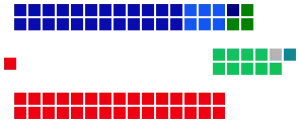2010 Australian Senate election
The following tables show state-by-state results in the Australian Senate at the 2010 federal election. Senators total 34 Coalition, 31 Labor, nine Green, one Democratic Labor Party, and one independent, Nick Xenophon.[1][2] New Senators took their places from 1 July 2011.
| |||||||||||||||||||||||||||||||||||||||||||||||||||||||||||||||||||||||||||||
40 of the 76 seats in the Australian Senate 39 seats needed for a majority | |||||||||||||||||||||||||||||||||||||||||||||||||||||||||||||||||||||||||||||
|---|---|---|---|---|---|---|---|---|---|---|---|---|---|---|---|---|---|---|---|---|---|---|---|---|---|---|---|---|---|---|---|---|---|---|---|---|---|---|---|---|---|---|---|---|---|---|---|---|---|---|---|---|---|---|---|---|---|---|---|---|---|---|---|---|---|---|---|---|---|---|---|---|---|---|---|---|---|
| |||||||||||||||||||||||||||||||||||||||||||||||||||||||||||||||||||||||||||||
 Senators elected in the 2010 federal election | |||||||||||||||||||||||||||||||||||||||||||||||||||||||||||||||||||||||||||||
| |||||||||||||||||||||||||||||||||||||||||||||||||||||||||||||||||||||||||||||
Quota
Senate Quota in each State are as follows
| Quota | Vote | Remarks |
|---|---|---|
| 1 | 14.3% | |
| 2 | 28.6% | |
| 3 | 42.9% | Equality |
| 4 | 57.1% | Majority |
| 5 | 71.4% | |
| 6 | 85.7% |
Senate Quota in each Territory are as follows
| Quota | Vote | Remarks |
|---|---|---|
| 1 | 33.4% | Equality |
| 2 | 66.7% | Majority |
Australia
| Party | Votes | % | Swing | Seats won | Total seats | Change | ||
|---|---|---|---|---|---|---|---|---|
| Liberal/National joint ticket [lower-alpha 1] | 3,740,002 | 29.40 | −1.28 | 8 | 17 | |||
| Liberal [lower-alpha 2] | 1,092,601 | 8.59 | −0.18 | 9 | 16 | |||
| Country Liberal (NT) | 39,268 | 0.31 | −0.01 | 1 | 1 | |||
| Coalition total | 4,871,871 | 38.30 | –1.47 | 18 | 34 | |||
| Labor | 4,469,734 | 35.13 | –5.17 | 15 | 31 | |||
| Greens | 1,667,315 | 13.11 | +4.07 | 6 | 9 | |||
| Family First | 267,493 | 2.10 | +0.48 | 0 | 0 | |||
| Democratic Labor | 134,987 | 1.06 | +0.14 | 1 | 1 | |||
| Total | 12,722,233 | 40 | 76 | |||||
| Invalid/blank votes | 495,160 | 3.75 | +1.20 | |||||
| Registered voters/turnout | 14,086,869 | 93.83 | ||||||
| Source: Commonwealth Election 2010 | ||||||||
New South Wales
|
| ||||||||||||||||||||||||||||||||||||||||||||||||||||||||||||||||||||||||||||||||||||||||||||||||||||||||||||||||||||||||||||||||||||||||||||||||||||||||||||||||||||||||||||||||||||||||||||||||||||||||||||||||||||||||||||||||||||||||||||||||||||||||||||||||||||||||||||||||||||||||||||||||||||||||||||||||||||||||||||||||||
Primary votes saw the Coalition and the Labor Party win two seats each before preferences were counted, with the Greens ahead of the Coalition for the fifth seat. Preferences from the Family First Party, the Christian Democrats and the Shooters and Fishers saw the Coalition reach the quota first, leading to Fiona Nash winning the fifth seat, while Coalition and Sex Party preferences saw the Liberal Democrats threatening the Greens for the sixth and final seat, but Labor preferences saw the Greens reach the quota. The end result was three seats Coalition, two seats Labor, and one seat Green.[4]
Victoria
|
| ||||||||||||||||||||||||||||||||||||||||||||||||||||||||||||||||||||||||||||||||||||||||||||||||||||||||||||||||||||||||||||||||||||||||||||||||||||||||||||||||||||||||||||||||||||||||||||||||||||||||||||||||||||||||||||||||||||||||||||||
The primary vote saw the Coalition win two seats, Labor win two seats and the Greens win one seat, leaving Labor leading for the final seat with a comfortable majority ahead of the Coalition, Family First, DLP and Australian Sex Party. It ended up being a tight race for the final senate seat in Victoria, with preferences from One Nation and the Christian Democrats saw the DLP move ahead of Family First into third place, but Australian Democrat and Liberal Democrat preferences saw the DLP getting overtaken by the Sex Party. However, the Sex Party was overtaken once again by the DLP's Family First preferences, and Sex Party preferences saw the DLP move into second place ahead of the Coalition, whose preferences allowed the DLP to overtake Labor to secure the sixth seat. The final results were two seats Coalition, two seats Labor, one seat Green and one seat Democratic Labor.[5]
Queensland
|
| ||||||||||||||||||||||||||||||||||||||||||||||||||||||||||||||||||||||||||||||||||||||||||||||||||||||||||||||||||||||||||||||||||||||||||||||||||||||||||||||||||||||||||||||||||||||||||||||||||||||||||||||||||||||||||||||||||||||||||||||||||||||||||||||||||||||||||||||||||
Primary votes saw the LNP and Labor both winning two seats, with the LNP and Greens having a sizable majority against Family First and the Sex Party for the final two seats. Labor and Australian Democrat preferences saw the Greens reaching the quota, while preferences from the Shooters and Fishers, One Nation, Liberal Democrats, Family First and Sex Party all saw the Australian Fishing and Lifestyle Party make a large gain on the Liberal National Party. However, the gain was not enough and the LNP ended up winning the final seat. The final result was three seats LNP, two seats Labor and one seat Green.[6]
Western Australia
|
| ||||||||||||||||||||||||||||||||||||||||||||||||||||||||||||||||||||||||||||||||||||||||||||||||||||||||||||||||||||||||||||||||||||||||||||||||||||||||||||||||||||||||||||||||||||||||||||||||||||||||||||||||||||||||||||||||||||||||||||||
The primary vote saw the Liberals winning three seats and Labor winning two, leaving the Greens with a very comfortable majority against the Nationals and the Sex Party. Socialist Alliance and Labor preferences saw the Greens easily reach the quota.[7]
South Australia
|
| ||||||||||||||||||||||||||||||||||||||||||||||||||||||||||||||||||||||||||||||||||||||||||||||||||||||||||||||||||||||||||||||||||||||||||||||||||||||||||||||||||||||||||||||||||||||||||||||||||||||||||||||||||||||
Primary votes saw both the Liberals and Labor winning two seats each, leaving the Greens leading while Labor was narrowly ahead of the Liberals. Sex Party preferences saw the Greens reach the quota to secure the fifth seat, while Family First preferences saw the Liberals overtake Labor to secure the sixth vacancy. The final result was three seats Liberal, two seats Labor and one seat Green.[8]
Tasmania
|
| ||||||||||||||||||||||||||||||||||||||||||||||||||||||||||||||||||||||||||||||||||||||||||||||||||||||||||||||||||||||||||||||||||||||||||||||||||||||||||||||||||||||
Primary votes saw the Liberals and Labor both win two seats and the Greens win one, which left Labor ahead of the Greens and the Liberals. It is possible that Liberal preferences may have pushed the Greens ahead of Labor, which would've led to them taking the final seat, but Shooters and Fishers preferences meant that the Liberals ended up ahead of the Greens, and Labor ended up taking the seat with Green preferences. The final result was three seats Labor, two seats Liberal and one seat Green.[9]
Territories
Australian Capital Territory
|
| |||||||||||||||||||||||||||||||||||||||||||||||||||||||||||||||||||||||||||
Labor Senator Kate Lundy was re-elected with well over a quota. Liberal Senator Gary Humphries was also re-elected, with just over (1.01x) a quota. Although the Greens received significantly more votes than in 2007, the two ACT Senators were elected on quotas, leaving no room for preference flows.[10]
Northern Territory
|
| |||||||||||||||||||||||||||||||||||||||||||||||||||||||||||||||||||||||||||||||||||||||||||||||||||
Country Liberals Senator Nigel Scullion, who is also deputy leader of the National Party of Australia, was re-elected with well over a quota of votes. Labor Senator Trish Crossin was also re-elected, with just over (1.04x) a quota of votes. Although the Greens received the next highest number of votes, the two NT Senators were elected on quotas, leaving no room for preference flows.[11]
See also
Notes
- The Liberal and National parties ran a joint ticket in New South Wales and Victoria. It includes the Liberal National Party in Queensland.
- The Liberals-only ticket ran in Western Australia, South Australia, Tasmania and the Australian Capital Territory.
- The National Party of Western Australia prior to and subsequent to the election were not in the federal Coalition agreement. Nationals WA MP Tony Crook stated that he was a crossbencher, and has said: "In every news report and press report we see, my number is being allocated in with the Coalition and it shouldn't be".[3] Thus, the party has been counted separately from the Coalition totals.
- The independenant senator was Nick Xenophon (South Australia).
References
- 2010 election Senate results by vote: AEC Archived 2010-09-01 at the Wayback Machine
- "2010 election Senate results by seat". ABC. 29 July 2010. Archived from the original on 11 May 2011. Retrieved 16 May 2011.
- Ker, Peter (26 August 2010). "Don't count me among Coalition, says Nat". The Age. Fairfax Media. Retrieved 27 August 2010.
- "Senate Results: New South Wales - Federal Election 2010 - ABC (Australian Broadcasting Corporation)". ABC. 29 July 2010. Retrieved 16 May 2011.
- "Senate Results: Victoria - Federal Election 2010 - ABC (Australian Broadcasting Corporation)". ABC. 29 July 2010. Retrieved 16 May 2011.
- "Senate Results: Queensland - Federal Election 2010 - ABC (Australian Broadcasting Corporation)". ABC. 29 July 2010. Archived from the original on 29 June 2011. Retrieved 16 May 2011.
- "Senate Results: Western Australia - Federal Election 2010 - ABC (Australian Broadcasting Corporation)". ABC. 29 July 2010. Retrieved 16 May 2011.
- "Senate Results: South Australia - Federal Election 2010 - ABC (Australian Broadcasting Corporation)". ABC. 29 July 2010. Retrieved 16 May 2011.
- "Senate Results: Tasmania - Federal Election 2010 - ABC (Australian Broadcasting Corporation)". ABC. 29 July 2010. Retrieved 16 May 2011.
- "Senate Results: Australian Capital Territory - Federal Election 2010 - ABC (Australian Broadcasting Corporation)". ABC. 29 July 2010. Retrieved 16 May 2011.
- "Senate Results: Northern Territory - Federal Election 2010 - ABC (Australian Broadcasting Corporation)". ABC. 29 July 2010. Retrieved 16 May 2011.




